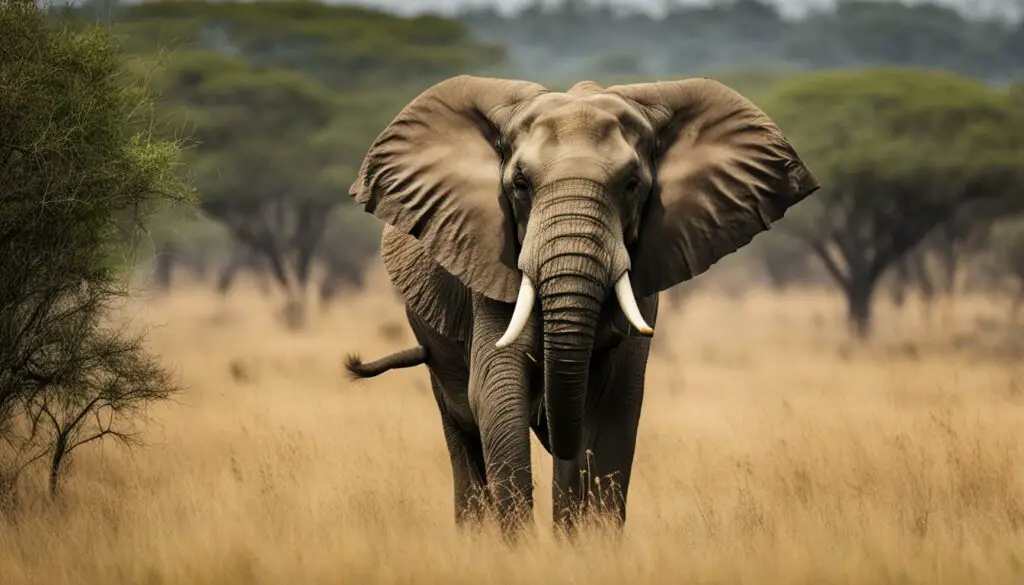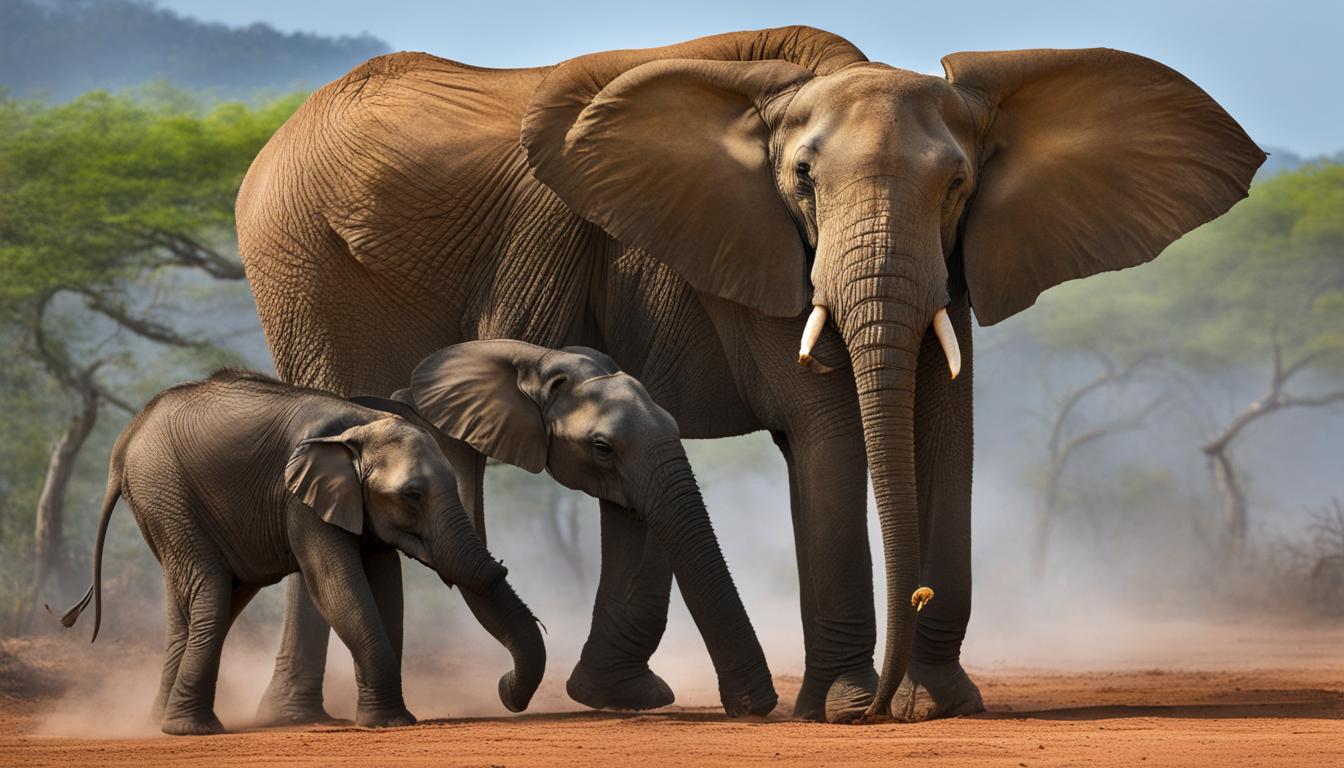Elephants are fascinating creatures that have evolved a multitude of adaptations to thrive in their unique environments. From their physical traits to their behavioral strategies, elephants have developed remarkable survival mechanisms that have allowed them to survive and prosper.
In this article, we will explore the various adaptations of elephants, including their habitat preferences, diet, behavior, physical traits, social structure, and the environmental influences that have shaped their evolution. We will also delve into the physiological changes and evolutionary traits that make elephants truly extraordinary beings.
By understanding these remarkable adaptations, we can gain a deeper appreciation for the majestic nature of elephants and the importance of preserving their habitats and ensuring their continued survival. So, let’s embark on this intriguing journey as we explore the incredible adaptations of these gentle giants.
Structural Adaptations of Elephants
Elephants have evolved a range of structural adaptations that allow them to thrive in their environments. One notable adaptation is their ability to cool off in hot climates. Asian elephants, for example, can flap their ears to create a cooling effect and even spray water on themselves or roll in mud to stay comfortable. This unique behavior helps them regulate their body temperature and avoid overheating.
Another structural adaptation of elephants is their feet. They have a thick pad of fatty tissue on the bottom of their feet, which helps distribute their weight evenly while walking. This adaptation allows them to navigate various terrains, including soft ground and rocky landscapes, without sinking or injuring their feet. It also helps them move silently, making them effective at sneaking up on prey or avoiding predators.
Elephants also possess a remarkable trunk, which serves multiple functions. It acts as a powerful appendage for grabbing and manipulating objects, such as food and tree branches. The trunk also enables elephants to drink water by sucking it up and then spraying it into their mouths. Additionally, it provides a keen sense of smell, allowing them to detect scents from long distances, including potential threats or food sources.
Traits of Elephants’ Structural Adaptations:
| Adaptation | Description |
|---|---|
| Ear Flapping | Helps to cool off in hot climates |
| Thick Foot Pads | Distributes weight evenly and aids in silent movement |
| Versatile Trunk | Acts as a tool for feeding, drinking, and smelling |
These structural adaptations of elephants contribute to their overall survival and ability to thrive in diverse habitats. By understanding and appreciating these unique features, we can gain a deeper insight into the remarkable capabilities of these gentle giants.
Physiological Adaptations of Elephants
Elephants have undergone remarkable physiological adaptations that allow them to thrive in their environments. One notable adaptation is their unique digestive system, which enables them to consume large quantities of vegetation despite the poor absorption of nutrients. Their hindgut fermentation process plays a crucial role in extracting nutrients from lower quality vegetation that would not be suitable for other herbivores.
This intricate digestive system not only aids in their survival but also has a significant impact on the environment. Many tree species in West Africa rely on the elephants’ digestive process for seed germination. As elephants consume fruits and vegetation, the seeds pass through their system, and through their excrement, they are dispersed across their habitat. This process not only helps regenerate the ecosystem but also contributes to the overall biodiversity of the region.
| Physiological Adaptations | Impact |
|---|---|
| Hindgut Fermentation | Aids in nutrient extraction from low-quality vegetation and seed germination |
| Seed Dispersal | Contributes to ecosystem regeneration and biodiversity |
Furthermore, elephants possess an extraordinary ability to endure long periods without water. They can store water in their bodies and efficiently regulate their body temperature through various physiological mechanisms. One such mechanism is their large ears, which they use to dissipate heat by flapping them. This helps cool the blood flowing through their capillaries and maintains their body temperature within a manageable range. These adaptations allow elephants to adapt and survive in diverse habitats, from arid savannahs to dense rainforests.

Physiological Adaptations: Key Points
- Elephants possess a unique digestive system that allows them to extract nutrients from low-quality vegetation.
- Their hindgut fermentation process aids in seed germination and contributes to ecosystem regeneration.
- Elephants can endure long periods without water and regulate their body temperature through their large ears.
“The physiological adaptations of elephants showcase their incredible ability to adapt and survive in challenging environments, while also playing a vital role in maintaining the balance of their ecosystems.” – Elephant Conservation Society
Behavioral Adaptations of Elephants
Elephants exhibit a wide range of behavioral adaptations that contribute to their survival and social structure. One of the most remarkable behaviors is their complex social organization. Elephants live in close-knit family groups led by a matriarch, a female elephant with extensive knowledge and experience. This social structure provides protection, support, and guidance for the group members, particularly the young calves. It allows them to navigate their environment more efficiently and increases their chances of survival.
Another fascinating behavioral adaptation of elephants is their use of tusks to create water sources. Elephants have the ability to dig deep wells using their tusks, providing themselves and other animals in the habitat with access to water. This behavior is especially crucial during periods of drought when water sources may be scarce. By creating these watering holes, elephants not only ensure their own survival but also benefit other species in their ecosystem.
Additionally, elephants’ migration patterns contribute to their behavioral adaptations. During their migrations, elephants create trails that benefit other species by providing easier travel routes and access to vegetation. These trails form natural corridors that facilitate movement and promote biodiversity in the surrounding areas. By shaping the landscape through their movement, elephants play a vital role in maintaining the balance of their ecosystems.
Table: Elephant Behavioral Adaptations
| Behavioral Adaptations | Description |
|---|---|
| Complex Social Structure | Elephants live in close-knit family groups led by a matriarch, providing protection and support for the group members. |
| Tusk-Watering | Elephants use their tusks to dig wells, creating water sources for themselves and other animals in the habitat. |
| Migration Trails | Elephants’ migration patterns create trails that benefit other species by providing easier travel routes and access to vegetation. |
In conclusion, the behavioral adaptations of elephants, including their complex social structure, tusk-watering behavior, and migration patterns, highlight their remarkable abilities to navigate and shape their environment. These adaptations not only contribute to their own survival but also have a positive impact on other species in their ecosystems. Understanding and appreciating these behavioral adaptations is crucial for conservation efforts and ensuring the long-term survival of these majestic creatures.
Environmental Influences on Elephant Adaptations
Elephants, as remarkable creatures, have adapted to their environments based on a variety of influential factors. Their adaptations are a result of the harsh conditions they face, including hot climates, occasional droughts, and the presence of predators. These environmental influences have shaped the physical, physiological, and behavioral traits of elephants, allowing them to thrive and survive in a wide range of habitats.
Physical Adaptations
One of the key physical adaptations of elephants is their large size, which acts as a defense against most predators. Their massive bodies make it difficult for predators to bring them down, with humans being their primary threat. Additionally, elephants have developed unique ways to regulate their body temperature in hot climates. They possess large ears that they can flap to cool the blood flowing through their capillaries. This mechanism helps them maintain a stable body temperature and manage the heat of their environment.
Furthermore, elephants have adapted to consume fibrous and protein-deficient vegetation, allowing them to survive in various habitats. Their ability to access and digest such vegetation gives them a competitive advantage over other herbivores that rely on higher quality food sources. This adaptation provides elephants with a diverse range of habitats in which they can find sustenance.
Behavioral Adaptations
In addition to physical adaptations, elephants have also developed behavioral strategies for their survival. Their migratory patterns, for example, create trails that benefit other species by providing easier travel routes and access to vegetation. By forging these paths, elephants contribute to the overall biodiversity of their environments. Moreover, elephants use their tusks to dig wells, creating water sources not only for themselves but for other animals as well. These water sources play a crucial role during periods of drought, supporting the survival of various species in the ecosystem.
“The adaptability of elephants to their environment is a testament to their incredible resilience and resourcefulness.”
Additionally, elephants exhibit complex social structures, living in close-knit family groups led by a matriarch. This social behavior provides protection and support for the group members, particularly the young calves. The cohesion and cooperation within elephant herds contribute to their survival and ability to thrive in their environments.
| Environmental Influence | Adaptation |
|---|---|
| Hot climates | Large ears for temperature regulation |
| Competition for food | Ability to consume fibrous and protein-deficient vegetation |
| Drought conditions | Migratory patterns that create water sources |
| Presence of predators | Large size as a defense mechanism |
Elephant Behavioral Communication and Survival Strategies
Elephants exhibit a remarkable array of adaptations that enable them to not only survive but thrive in their environments. One aspect of their adaptations that plays a crucial role in their survival is their unique communication methods. Elephants utilize infrasound, which is a low-frequency sound below the range of human hearing, to communicate with each other over long distances. This allows them to coordinate group movements and warn others of potential threats. It is truly fascinating to witness how these gentle giants utilize sound to stay connected and ensure the safety of their group.
Another important survival strategy of elephants is their herding behavior. They typically live in close-knit family groups led by a matriarch, who acts as the leader and protector of the group. This social structure provides a sense of security and support for the group members, especially the young calves. By sticking together and relying on each other, elephants increase their chances of survival in challenging environments.
“Elephants’ impact on the environment is also a part of their survival strategy. Their migration patterns create trails that benefit other species by providing easier travel routes and access to vegetation.”
Furthermore, elephants’ impact on the environment itself is a part of their survival strategy. During their migration patterns, they bring down vegetation, which helps maintain the balance of the ecosystem. By creating open areas and clearing out overgrown vegetation, elephants provide resources for smaller species and contribute to the overall health of their habitat. Their presence and actions have a ripple effect on the entire ecosystem, showcasing the interconnectedness of life in the wild.
| Survival Strategies | Examples |
|---|---|
| Infrasound communication | Coordinating group movements, warning of potential threats |
| Herding behavior | Living in close-knit family groups led by a matriarch, providing protection and support |
| Environmental impact | Creating trails, clearing vegetation, providing resources for smaller species |
The survival strategies of elephants are not only fascinating but also essential for their well-being and the balance of their ecosystems. By understanding and appreciating these adaptations, we can develop a deeper respect for these magnificent creatures and the intricate web of life they are a part of. It is crucial that we continue to protect their habitats and ensure their survival for generations to come.
Elephant Evolutionary Traits
Elephants have undergone significant evolutionary changes over time, resulting in their unique physical traits and adaptations that contribute to their survival in various environments. These evolutionary traits demonstrate the remarkable capabilities of these gentle giants.
One of the most distinctive features of elephants is their trunk, which has evolved to be a versatile tool for feeding, drinking, and communication. The trunk is an elongated muscular structure that is capable of precise movements, allowing elephants to grasp and manipulate objects with ease. It also serves as a powerful sensory organ, enabling them to detect scents and vibrations in their surroundings.
Another notable evolutionary trait of elephants is their tusks. While these ivory structures have unfortunately made elephants targets of poaching, they serve important functions in their natural behavior. Elephants use their tusks for stripping bark, digging for water, and accessing essential minerals in the ground. Their tusks also play a role in social interactions, such as asserting dominance and attracting mates.
Evolutionary Traits of Elephants
| Traits | Description |
|---|---|
| Trunk | A versatile appendage that acts as a multipurpose tool and sensory organ. |
| Tusks | Ivory structures used for various functions including foraging, digging, and social interactions. |
| Size | Evolved to be large, providing defense against most predators. |
| Teeth | Large molars adapted for chewing tough vegetation. |
These evolutionary traits have allowed elephants to adapt and thrive in their habitats, demonstrating the incredible resilience and ingenuity of these magnificent creatures.
How does the use of their trunks help elephants adapt to their environments?
Elephant trunk activities are essential for an elephant’s adaptation to its environment. Their trunks help them in multiple ways, such as lifting and manipulating objects, gathering food and water, communicating with other elephants, and even defending themselves from potential threats. The trunk’s versatile nature allows elephants to survive and thrive in various habitats, showcasing their remarkable adaptability.
Conclusion
Elephants exhibit a remarkable array of adaptations that enable them to thrive in their environments. From their structural, physiological, and behavioral adaptations to their evolutionary traits, these gentle giants have innovatively evolved to overcome the challenges they face.
Through their ability to cool off in hot climates, unique digestive system, and complex social structure, elephants have developed remarkable survival strategies. They use their structural adaptations, such as flapping their ears and using their trunk for multiple functions, to cope with environmental influences and ensure their survival.
By understanding and appreciating these adaptations, we can develop a deeper appreciation for the incredible capabilities of elephants. Their size, trunk, tusks, and other physical traits have evolved through natural selection to enhance their survival. We must recognize the importance of conservation efforts to protect their habitats and ensure the continued existence of these magnificent creatures.
As we continue to study and learn from elephants’ adaptations, we gain valuable insights into the complex web of life and the interconnectedness of species within their ecosystems. By supporting conservation initiatives and preserving their habitats, we not only safeguard the future of elephants but also contribute to the preservation of biodiversity and the well-being of our planet as a whole.
How does the use of their trunks help elephants adapt to their environments?
Elephant trunk activities are essential for an elephant’s adaptation to its environment. Their trunks help them in multiple ways, such as lifting and manipulating objects, gathering food and water, communicating with other elephants, and even defending themselves from potential threats. The trunk’s versatile nature allows elephants to survive and thrive in various habitats, showcasing their remarkable adaptability.
Conclusion
How have elephants adapted to their environments?
Elephants have evolved a wide range of adaptations that enable them to thrive in their environments. These adaptations include structural, physiological, and behavioral changes that allow them to cope with the challenges of their habitats.
What are the structural adaptations of elephants?
One key structural adaptation of elephants is their ability to cool off in hot climates. They can flap their ears to create a cooling effect, spray water on themselves, or roll in mud to stay comfortable. Their feet are equipped with a thick pad of fatty tissue for even weight distribution, and their unique trunk serves multiple functions such as smelling, touching, transferring food and water, and providing a keen sense of smell. Their large molars are specially designed for chewing fibrous plant materials.
What are the physiological adaptations of elephants?
Elephants have a unique digestive system that allows them to consume large amounts of vegetation despite the poor absorption of nutrients. Their hindgut fermentation process enables them to extract nutrients from lower quality vegetation that would not be suitable for ruminants. This digestive system also plays a key role in seed germination, as many tree species rely on the elephants’ digestive process for germination.
What are the behavioral adaptations of elephants?
Elephants have a complex social structure, usually living in close-knit family groups led by a matriarch. This social structure provides protection and support for the group members, particularly the young calves. They also use their tusks to dig wells, creating multiple water sources for themselves and other animals. Their migration patterns create trails that benefit other species by providing easier travel routes and access to vegetation.
How do environmental influences affect elephant adaptations?
Elephants have evolved to thrive in hot and often inhospitable conditions, with occasional droughts and predators. Their massive size acts as a defense against most predators, with humans being the only significant threat. In hot climates, elephants use their large ears to regulate their body temperature. Their ability to access and consume fibrous and protein-deficient vegetation allows them to survive in a wide range of habitats.
How do elephants communicate and survive in their environments?
Elephants utilize low-pitched sounds called infrasound to communicate with each other over long distances. This helps them coordinate group movements and warn others of potential threats. They also exhibit herding behavior and form protective circles around young calves. Elephants’ impact on the environment, such as bringing down vegetation during migration, also provides resources for smaller species.
How have elephants evolved over time?
Elephants have undergone evolutionary changes to adapt to their environments. Their large size, trunk, tusks, and other physical traits have developed through natural selection to enhance their survival. For example, their trunk has evolved to be a versatile multi-purpose tool, and their tusks serve multiple purposes such as stripping bark, digging for water, and accessing essential minerals in the ground.
Elephants exhibit a remarkable array of adaptations that enable them to thrive in their environments. From their structural, physiological, and behavioral adaptations to their evolutionary traits, these gentle giants have innovatively evolved to overcome the challenges they face. By understanding and appreciating these adaptations, we can develop a deeper appreciation for the incredible capabilities of elephants and the importance of conservation efforts to protect their habitats.







